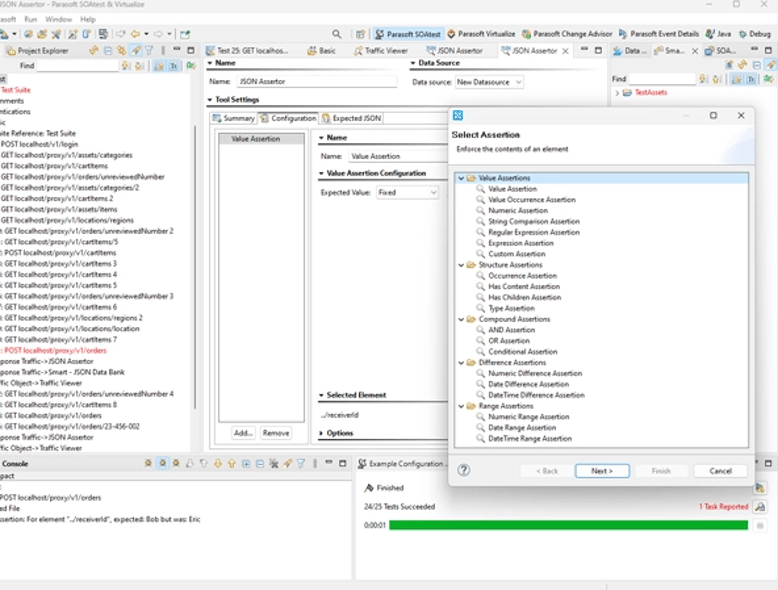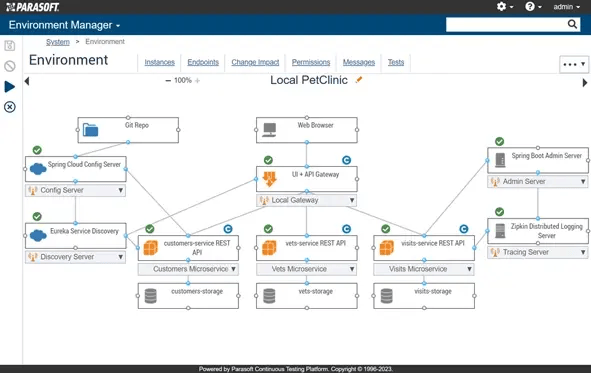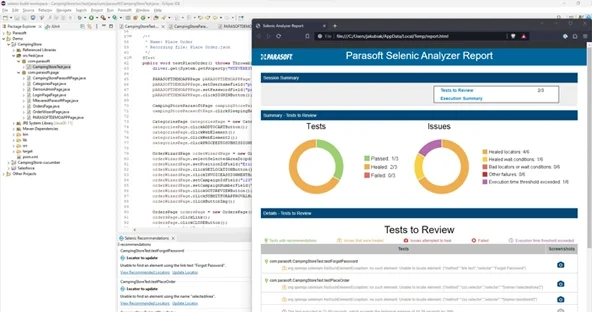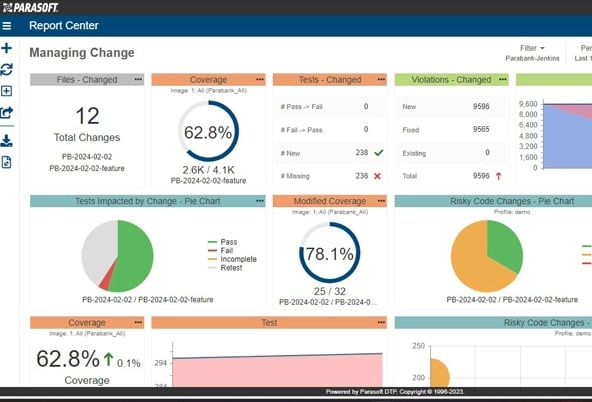See real examples of how you can use AI in your testing. Right now. Learn More >>
Advanced AI-powered testing solutions for Java offer unparalleled productivity and optimized workflows across every stage of the SDLC for applications to ensure continuous quality.
Deliver high-quality, secure, and reliable software to the market faster with Parasoft’s automated software testing solutions tailored for Java applications. Seamlessly optimize testing processes throughout the SDLC, reducing project costs by increasing productivity and efficiency.
Shift security left. Get broad support for security standards like OWASP, CWE, CERT, and more. Remediate faster with AI-driven triaging and generated code fixes.
Jump to: Static Analysis »
Turbocharge productivity with AI-powered automated unit test generation. Drive code coverage with high-quality test cases and meet requirements with ease.
Jump to: Unit Testing »
Use AI-enhanced functional testing and service virtualization solutions to easily create robust test scenarios and control environments for stable automation.
Jump to: Functional Testing »
Harness AI for efficient, robust Selenium test automation and increase the scalability, maintainability, and efficiency of web UI testing.
Jump to: Selenium Testing »
Analyze coverage data from all testing practices for a complete application coverage view. Identify coverage gaps and bridge them effectively.
Jump to: Code Coverage »
Get feedback 90% faster with AI-based test impact analysis for unit testing, automated functional testing, and manual regression testing.
Jump to: Test Impact Analysis »
Ensure thorough testing with quality metrics. Release applications with confidence that they’re safe, secure, and reliable.
Jump to: Reporting »

Use Parasoft Jtest’s extensive Java static analysis checkers and testing techniques to ensure Java code quality. Teams can verify compliance with security standards (OWASP, CWE, CERT, PCI DSS, and more) and custom coding standards using built-in or user-defined custom rules. Shift-left testing detects issues early, while AI rapidly resolves defects and security vulnerabilities to halt late-stage issues.
In addition:
Striking a balance between thoroughness and efficiency poses a critical challenge for dev teams grappling to meet Java unit testing and code coverage requirements while sustaining high levels of development productivity.
With AI-enhanced Jtest, teams gain a head start in building effective unit test suites and reaching code coverage targets. Jtest uses proprietary built-in AI algorithms to swiftly generate a suite of JUnits for uncovered lines of code, rapidly and substantially increasing code coverage metrics.
Integrated within the IDE, Jtest’s Unit Test Assistant provides actionable AI-insights to enhance test stability. Improve developer efficiency using Jtest’s IDE-based Live Unit Testing to autonomously identify and run unit tests affected by code changes and provide continuous feedback directly in the IDE.
For added customization, teams can integrate Jtest with various LLM providers like OpenAI and Azure OpenAI to tailor test cases based on specific requirement prompts. New users can get onboard quickly with Jtest’s AI Assistant, an IDE-embedded chat interface that leverages generative AI to provide real-time technical guidance and support. Jtest provides development teams with a complete solution for Java quality, enabling them to better balance testing activities and requirements with new feature development.
Parasoft SOAtest coupled with Virtualize for service virtualization revolutionizes how teams achieve continuous test automation goals. One major challenge teams face is the lack of comprehensive test coverage. SOAtest addresses this with robust AI-enhanced capabilities that enable teams to create and execute a diverse range of tests to ensure thorough coverage across all layers of the application:


Seamless integration into popular CI/CD pipelines enables execution, quality gate enforcement, and reporting. Teams can optimize testing of pull requests by using SOAtest’s test impact analysis to identify and run the subset of test cases required to validate the application changes. Continuously publishing test results into Parasoft DTP provides:
Another challenge is the dependency on external systems or services, which can impede test execution and slow down the automation process. Teams can simulate the behavior of these dependencies with Virtualize to ensure seamless, uninterrupted test automation, even in complex environments or architectures like distributed microservices.
Application teams encounter the following common challenges in Selenium testing:

Parasoft Selenic, augmented with AI/ML capabilities, empowers development teams to:
Download Free Edition of Parasoft Selenic »
Collect, monitor, and analyze code coverage from unit, functional, and manual testing for Java applications. Drive higher levels of code coverage by understanding what lines of code have been tested and targeting coverage gaps.
Meeting code coverage requirements in Java projects poses challenges due to complex modern software systems, diverse testing scenarios, and the need for comprehensive testing across components and functionalities. Use our solution to:
Read Blog Post: Application Coverage Is the Most Powerful Metric You’re Not Measuring »
Parasoft provides broad and flexible AI-enhanced Test Impact Analysis (TIA) support across the Java software development lifecycle:
Parasoft’s Java code coverage agents collect detailed coverage data across test types and executions (manual or automated), then pass this data the TIA engine within Parasoft tools. The AI intelligently maps code changes to impacted tests and automatically selects only the relevant test cases to execute.
Release applications with confidence knowing they’re safe, secure, and reliable based on quality metrics from all of the team’s testing practices including static analysis, unit testing, functional testing, nonfunctional testing, and code coverage.
Teams can publish testing results from the CI/CD pipelines into Parasoft DTP for advanced reporting and build-to-build trends analysis. Using predefined or customized dashboards, get a specific view of testing results and trends data to easily track the following:


Go beyond simple reporting using DTP’s award-winning analytics widgets for insights into business risks and productivity improvements. Streamline triaging of static analysis results by leveraging AI/ML-enhanced analytics and recommendations. Train DTP’s ML models to understand the violations to fix and who to assign them to. Our optional integration with OpenAI/Azure OpenAI providers enables teams to use DTP’s CVE match analysis, ensuring remediation efforts focus on real security vulnerabilities.
Teams can customize the analytics to measure and monitor key performance indicators to assess potential risks, prioritize findings, and validate that applications meet quality, security, and reliability requirements to ensure release readiness.
Read Blog: Modern Analytics for Modern Software Testing »
